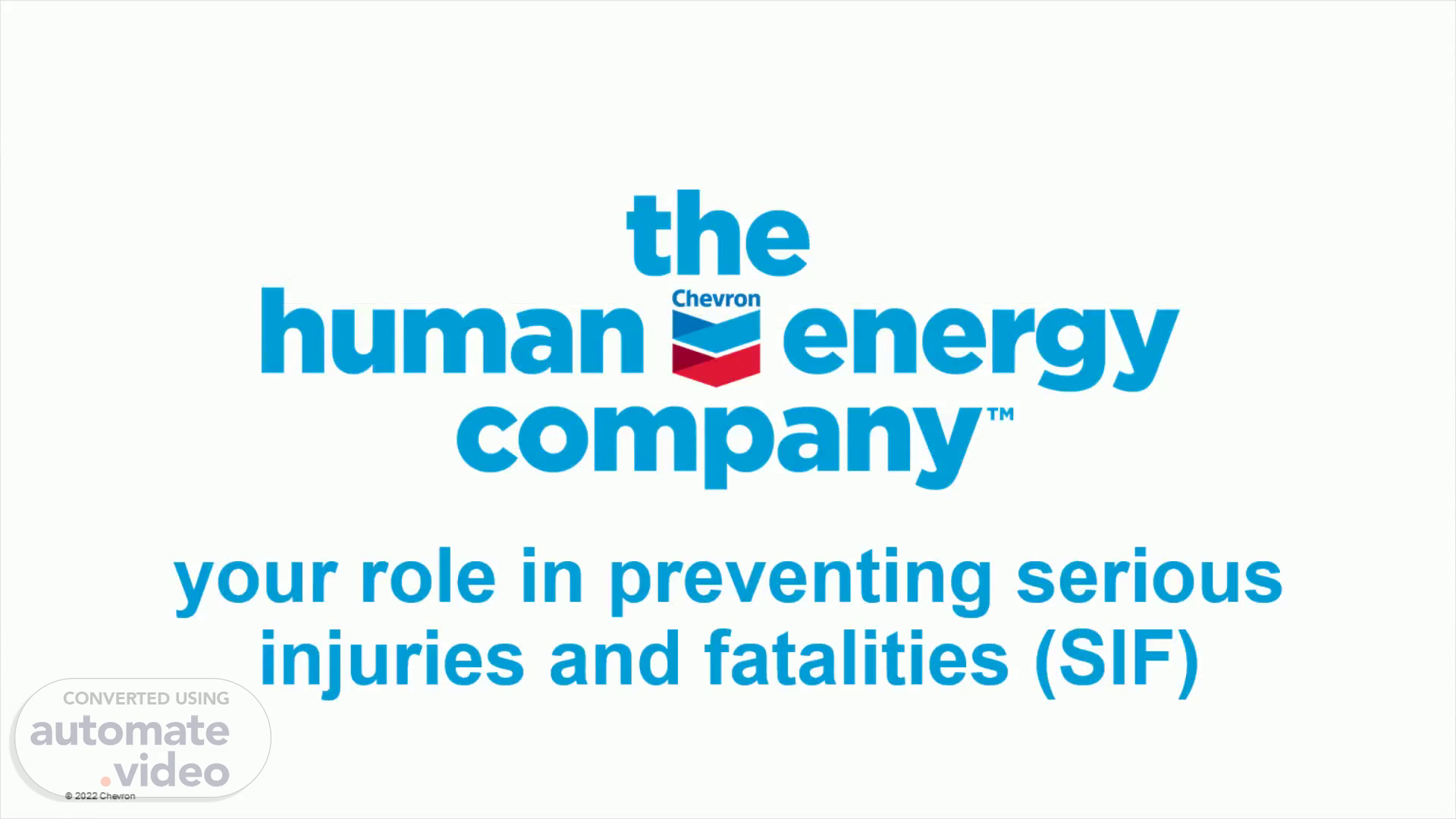
your role in preventing serious injuries and fatalities (SIF)
Scene 1 (0s)
your role in preventing serious injuries and fatalities (SIF).
Scene 2 (6s)
Message from Agbami FPSO HSE Supervisor. Insert picture.
Scene 3 (22s)
You will learn about:. Workplace hazards identification and control.
Scene 4 (44s)
Workplace Hazards Identification and Control.
Scene 5 (50s)
A Hazard is a condition or action that has the potential for an unplanned release of, or unwanted contact with, an energy source that may result in harm or injury to people, property or the environment..
Scene 6 (1m 3s)
To eliminate them before:. Someone gets hurt or even fatally injured.
Scene 7 (1m 26s)
Use the Energy Wheel to:. Energy Wheel. Identify the sources of energy that are associated with your work.
Scene 8 (1m 40s)
Gravity :The force that attracts all objects to the surface of the earth..
Scene 9 (1m 53s)
Motion : The change in the position of objects or substances including the human body..
Scene 10 (2m 5s)
Gravity :The force that attracts all objects to the surface of the earth..
Scene 11 (2m 36s)
Mechanical : The energy components of a mechanical system, such as rotation, vibration or motion within an otherwise stationary piece of equipment or machinery..
Scene 12 (2m 49s)
Electrical : The presence and flow of an electric charge..
Scene 13 (3m 1s)
Mechanical : The energy components of a mechanical system, such as rotation, vibration or motion within an otherwise stationary piece of equipment or machinery..
Scene 14 (3m 32s)
Pressure : The energy applied by a liquid or gas that has been compressed or is under a vacuum..
Scene 15 (3m 44s)
Temperature : The measurement of differences in the thermal energy of objects or the environment which the human body senses as either heat or cold..
Scene 16 (3m 57s)
Pressure : The energy applied by a liquid or gas that has been compressed or is under a vacuum..
Scene 17 (4m 28s)
Chemical :The energy present in chemicals with potential to create a physical or health hazard..
Scene 18 (4m 40s)
Biological : Living organisms that can present a hazard..
Scene 19 (4m 53s)
Chemical :The energy present in chemicals with potential to create a physical or health hazard..
Scene 20 (5m 21s)
Radiation : The energy emitted from radioactive elements or sources and naturally occurring radioactive materials (NORM)..
Scene 21 (5m 34s)
Sound : Sound is produced when a force causes an object or substance to vibrate, and the energy is transferred through the substance in waves..
Scene 22 (5m 46s)
Radiation : The energy emitted from radioactive elements or sources and naturally occurring radioactive materials (NORM)..
Scene 23 (6m 15s)
Temperature. Gravity. Motion. Identifying energy sources in a work environment.
Scene 24 (6m 37s)
Biological. Gravity. Pressure. Identifying energy sources in a work environment.
Scene 25 (6m 58s)
Eliminate the hazards by:. Hierarchy of Controls effective Elimination Substitution Engineering Controls Administrative Controls PPE Least effective Physiülly remove the hazard Replace the hazard Isolate people from the hazard Change the way people work Protect the worker with personal Protective Equipment.
Scene 26 (7m 19s)
Prevent the release of unwanted energy by using:.
Scene 27 (7m 48s)
Protect from the release by:. Most Least Hierarchy of Controls Elimination Substitution Engineering Controls Administrative Controls PPE Physically remove the hazard Replace the hazard Isolate pople from the hazard Change the way FOPIe work Protect the worker with Personal Protætive Equipment.
Scene 28 (8m 13s)
Safe planning and execution of work.
Scene 29 (8m 25s)
Plan and execute all high-risk jobs by:. using all applicable permits.
Scene 30 (8m 39s)
Use applicable hazard analysis tools for all high-risk jobs. Ensure you participate fully in:.
Scene 31 (9m 2s)
Use the listed SYLAs and SWCs to physically and visually verify that critical life-saving safeguards / controls are in place and functioning..
Scene 32 (9m 29s)
Near miss reporting.
Scene 33 (9m 36s)
A Near miss is any unplanned event having a potential but unrealized consequence for injury/illness or damage to property, the environment, the company’s reputation or financial performance..
Scene 34 (9m 52s)
Near misses are reported to:. prevent injury, environmental/property damage, and financial loss..
Scene 35 (10m 19s)
Fitness For Duty (FFD).
Scene 36 (10m 25s)
Ensure you have a valid certificate of fitness before reporting to work..
Scene 37 (10m 46s)
Stop Work Authority (SWA).
Scene 38 (10m 52s)
You can stop unsafe acts and conditions to prevent injuries and loss incidents..
Scene 39 (11m 18s)
Your Key Actions to Prevent SIF.
Scene 40 (11m 25s)
Know the hazards in your work that can hurt or harm you or your co-workers or cause other high-consequence incidents..
Scene 41 (11m 41s)
Take ownership of the safeguards required for your work and ensure they are in place and functioning before you start work..
Scene 42 (12m 8s)
Stop work if safeguards are missing or ineffective. Use your Stop Work Authority!.
Scene 43 (12m 34s)
Access the following SIF resources when conducting high risk jobs:.